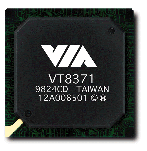Athlon Motherboard Roundup - March 2000
by Anand Lal Shimpi on March 27, 2000 12:27 AM EST- Posted in
- Motherboards
Since this roundup isn’t exclusive to motherboards based on the AMD 750 chipset, we’ll be discussing the features of both the AMD 750 and the VIA KX133 Athlon chipsets.
The AMD 750 chipset wasn’t originally intended to be the launch chipset for the Athlon, nor was it intended to be the only Athlon chipset available in 1999 and into 2000. Instead, VIA and ALi were supposed to have their solutions ready to go at the launch of the Athlon. Closer to the Athlon launch date, it became clear that this wasn’t a realistic goal, and thus, the burden fell on AMD to produce the only Athlon chipset available at the launch of the CPU.
Luckily, the AMD 750 turned out to be a fairly solid solution. The design is split, as are most non-Intel chipsets, into a North and a South Bridge chip.
The AMD 751 North Bridge handles all the communication between the memory masters and the system memory itself. The 751 doesn’t offer many unique features other than its ability to interface with the Athlon’s EV6 bus, which operates at 100MHz DDR.
The 751 features AGP 2X support and support for the 1:1 and 2:3 AGP to FSB frequency ratios, which do more than cut it because of the 100MHz operating frequency of the FSB.
From a standpoint of memory support, the 751 features SDRAM support running at a 1:1 ratio with the FSB frequency. This means that, in most cases, the memory bus will be stuck at 100MHz, which is an area that the Athlon lags behind, compared to the Pentium III on the i820 platform: memory bandwidth.
The 751 is coupled with the AMD 756 South Bridge, which brings Ultra ATA 66 support to the AMD 750 chipset. Other than that, the 756 offers the usual features of any South Bridge including an integrated PCI-to-ISA bridge, which eliminates the need for a second chip to provide support for any ISA slots on-board.
 VIA’s
KX133 picks up where the 751 left off and adds a few features that were lacking
from AMD’s solution. The chipset, as with all VIA chipsets, is split into the
classic North and South Bridge design.
VIA’s
KX133 picks up where the 751 left off and adds a few features that were lacking
from AMD’s solution. The chipset, as with all VIA chipsets, is split into the
classic North and South Bridge design.
The KX133’s 371 North Bridge is virtually identical to the AMD 751 with two major exceptions; it allows for a 4:3 Memory to FSB frequency ratio, which allows for a 133MHz memory bus frequency, and it also supports AGP 4X transfer modes. The latter is more of a marketing feature rather than one that offers a tangible gain in performance. The increase in memory frequency does help the Athlon out quite a bit, but the 1.06GB/s of memory bandwidth still isn’t enough to saturate AGP 4X.
The 686A South Bridge is where the KX133 truly excels, simply because it is a highly integrated solution which helps to bring down the overall cost of motherboards that use the chip. The 686A offers the same features as the AMD 756 in addition to integrated hardware monitoring and I/O controller support, which ends up saving in PCB space as well as chip costs.










0 Comments
View All Comments